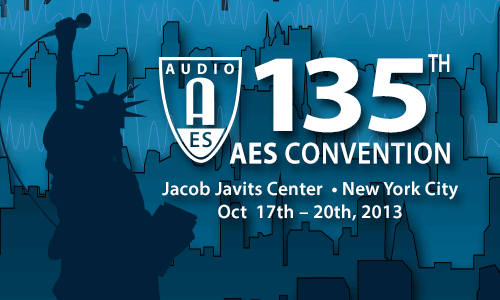AES New York 2013
Engineering Brief EB2
EB2 - Recording & Production
Friday, October 18, 12:00 pm — 12:45 pm (Room 1E07)
Chair:
Scott Levine, Skywalker Sound - San Francisco, CA, USA; The Centre for Interdisciplinary Research in Music Media and Technology - Montreal, Quebec, Canada
EB2-1 Controlling Drum Bleed with Laser Vibrometry—Andrew Greenwood, Sennheiser Electronic - San Francisco, CA, USA; Sebastian Chafe, Sennheiser Technology and Innovation - San Francisco, CA, USA
Using multiple microphones to capture the sound of multiple drums on a drum kit is common practice. As well, the bleed captured by such a setup is a common problem for sound engineers. Gating is often used in an attempt to manage drum and instrument bleed into individual drum channels. However, the overlap in amplitude and frequency content of different drums makes gating based solely on the microphone audio difficult and unwanted triggering of the gate is a common problem. By measuring the physical vibration of the drum head using simple laser vibrometry and using this signal to run the sidechain of a gate, the dynamic range of the gate’s signal follower is increased and false triggering is easier to avoid. This allows for more precise control over each drum channel’s tone and dynamics
Engineering Brief 109 (Download now)
EB2-2 The Urban Mix Engineer—Paul "Willie Green" Womack, Willie Green Music - Brooklyn, NY, USA
Although hip-hop is over 40 years old and influences the sound of everyone from Stevie Wonder to Taylor Swift, the term "hip-hop engineer" often evokes visions of kids with cracked software and distorted records. This presentation explores arguments often referenced in this ongoing debate of skill, including mixing "real vs. synthetic" instruments, the loop based nature of hip-hop, and mixing samples. It also illustrates a time when engineers in other genres once overcame similar criticisms. Providing an honest, first-hand look at what’s involved in mixing urban records, and the hurdles that exist in and out of the studio, this presentation sheds light on the importance of the mixing engineer, in any genre, as a vital part of the arrangement process.
Engineering Brief 110 (Download now)
EB2-3 Subjective Comparison of Surround Microphone Recording Techniques Presented With and Without Video—Luiz Fernando Kruszielski, Globo TV Network - Rio de Janeiro, Brazil; Tokyo University of the Arts - Tokyo, Japan
The comparison of different setups of microphones for surround recordings of music is a topic that has a large interest in the audio community. Although it is known that image has a strong effect on sound perception, particularly in spatial aspects, very little research had been done aiming the surround sound recordings with accompanied video. To compare possible influences in this perception, a test was created using five different surround recording techniques that was done simultaneously at a Brazilian carnival parade. The subjects were presented to the sound with and without video and asked to rate four different aspects: localization, deepness, immersion, and preference. The results show that there is a difference in perception depending on the presence or absence of video.
Engineering Brief 111 (Download now)
